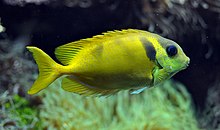Neopterygii
| Neopterygii Temporal range: Late Permian–recent |
|
|---|---|
 |
|
| Siganus corallinus | |
| Scientific classification | |
| Kingdom: | Animalia |
| Phylum: | Chordata |
| Class: | Actinopterygii |
| (unranked): | Actinopteri |
| Subclass: | Neopterygii |
| Infraclasses | |
Holostei
Teleostei
See text for orders.
Neopterygii are a group of Actinopteri animals. Neopterygii means "new fins". Only a few changes occurred during their evolution from the earlier actinopterygians. They appeared sometime in the Late Permian, before the time of the dinosaurs. The Neopterygii are a very successful group of fish, because they can move more rapidly than their ancestors. Their scales and skeletons began to lighten during their evolution, and their jaws became more powerful and efficient. While electroreception and the ampullae of Lorenzini are present in all other groups of fish, with the exception of hagfish (although hagfish are not Actinopterygii, they are Agnathans}, Neopterygii have lost this sense, even if it has later been re-evolved within Gymnotiformes and catfishes, which possess nonhomologous teleost ampullae.
A very important step in the evolution of the actinopterygian fishes is the origin of the Neopterygii, with the acquisition of a better control of the movements of both dorsal and anal fins, resulting in an improvement in their swimming capabilities. They additionally acquired several modifications in the skull, which allowed the evolution of different feeding mechanisms and consequently the colonization of new ecological niches. All of these characters represented major improvements, so that the Neopterygii became the dominant group of fishes (and, thus, taxonomically of vertebrates in general), and they also include the vast majority of the modern fishes, the teleosts.
...
Wikipedia
